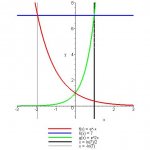alyssa23851
New member
- Joined
- May 10, 2010
- Messages
- 1
I was hoping I could get some help on this. I have it worked down until nearly the end, but I can't figure out what to do or if I'm even doing this right because I haven't used e's since the begining of this year.
The instructions are as follows:
Find the area bounded by the graph of f(x) = e^-x , g(x) = e^2x , and h(x) =7.
For my bounds, I have -ln7 to 0 for h(x) and f(x), and 0 to (ln7)/2 for h(x) and g(x).
For the intergral f(x) and h(x), I have 7-3^-x.
I took the derivative:
7x+e^-x from -ln7 to 0
For the intergral of g(x) and h(x), I have 7-e^2x.
I took the derivative:
7x-1/2e^2x from 0 to ln7/2
and combined them, plugging in my bounds:
[{7(0)+e^-0}-{7(-ln7)+e^ln7}]+[{7(ln7)/2-1/2e^[(ln7)/2]}-{7(0)+e^-0]
Of course, I went by the right order of operations.
From here, I don't know what to do. Because I keep checking my work with another website, and I cannot understand how they got the answer they did. I know it looks confusing, but I would greatly appreciate some help. Thankyou so much!
The instructions are as follows:
Find the area bounded by the graph of f(x) = e^-x , g(x) = e^2x , and h(x) =7.
For my bounds, I have -ln7 to 0 for h(x) and f(x), and 0 to (ln7)/2 for h(x) and g(x).
For the intergral f(x) and h(x), I have 7-3^-x.
I took the derivative:
7x+e^-x from -ln7 to 0
For the intergral of g(x) and h(x), I have 7-e^2x.
I took the derivative:
7x-1/2e^2x from 0 to ln7/2
and combined them, plugging in my bounds:
[{7(0)+e^-0}-{7(-ln7)+e^ln7}]+[{7(ln7)/2-1/2e^[(ln7)/2]}-{7(0)+e^-0]
Of course, I went by the right order of operations.
From here, I don't know what to do. Because I keep checking my work with another website, and I cannot understand how they got the answer they did. I know it looks confusing, but I would greatly appreciate some help. Thankyou so much!

